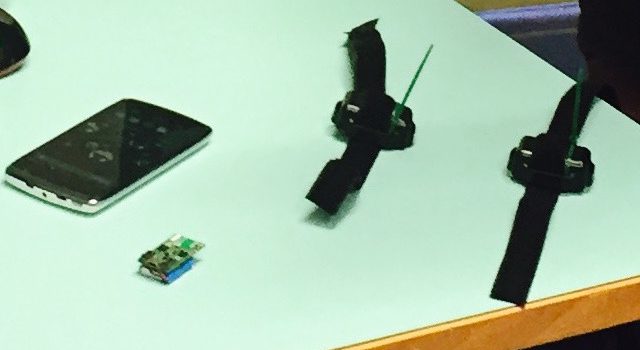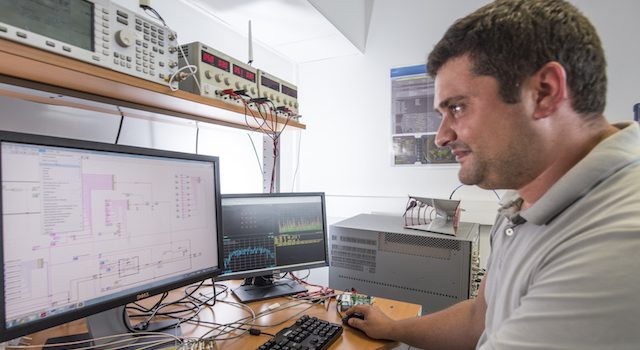
Body-Area Networks (BANET)



The main objective of the CITI’s radio communication systems experimentation facility (the “radio” room) is to provide to the researchers working on antenna and analog radio front ends domains, the opportunity validate their theoretical concepts through experimental setups. This facility features all the hardware and software tools needed in order to conceive, model and test the radio interfaces for the next generations of wireless communications systems. Here, the influence of the radio interface parameters such as noise, sensitivity, nonlinearity, etc. on the transmission quality is quantified thanks to a versatile platform combining hardware and software capabilities and being able perform experiments in RF, IF or baseband domain. Each year, the platform hosts a dozen of graduate students from INSA Electrical Engineering department, PhD and post doc from CITI laboratory.
The experimentation facility has two arbitrary waveform generators (Keysight’s ESG4438C and Rohde & Schwarz’s SMBV 100A), able to generate complex waveforms and a two path vector signal analyzer having 36 MHz bandwidth and able to process signals up to 6GHz. By using this equipment, MIMO 2×2 experiments can be conducted. This platform is driven by the Kesight’s ADS software and Error Vector Magnitude (EVM) and Bit Error Rate (BER) measurements can be performed.
The “radio room” is also equipped with a high performance oscilloscope: Keysight’s DSO9064A, 4 analog channels, 10 GSa/s and 600 MHz bandwidth one. Together with this oscilloscope, a current probe is available and power consumption measurements can be performed.
Together with the performance evaluation, the energy consumption is one of the crucial issues of next generation of radio interfaces. The experimentation platform is also equipped with a “homemade” power consumption measurement facility which is built around a National Instruments PXI 5105, 8 channels, 12 bits resolution and 60 MHz bandwidth digitizer. This measurement platform was specially conceived to measure the energy consumption of the communicating objects.
The radio communication systems experimental facility takes great benefit from the new born FIT(Future Internet of Things) CortexLab platform. Indeed, the home made radio front ends conceived and developed in the “radio room” can then be tested in the Cortexlab facility which proposes a complex environment. The two platforms are complementary since Cortexlab is primarily designed have a fixed hardware infrastructure and agile programming capabilities. A MIMO 4×4 National Instruments high performance equipment used jointly by Cortexlab to perform channel model extraction and radio front end characterization. The equipment is built around NI PXIe-5673 VSG and NI PXIe-5644R VST and is able to analyze communications using the most recent communication protocols such as LTE-A.
In addition to that, the” radio room” is equipped with all the tools needed for the analog front end prototyping: a 8 GHz Vector Network Analyzer, soldering station, low frequency generators, DC power supply, high resolution multimeters, etc. Moreover, the Keysight’s ADS together with the VSA software are deployed on a high performance workstation.
This experimental facility allowed to characterize the behavior of a double IQ front-end conceived by the researchers of the CITI laboratory in collaboration with the Orange Labs and patented in 2011. This radio front end is able to simultaneously process signals on two communication channels while decreasing the energy consumption by 30% compared to a classical stack radio front end approach.
More recently, in 2015 the same experimental facility allowed building and characterizing a quasi-passive wake-up radio demonstrator which validates the approach proposed by the researchers of CITI laboratory. Our approach consists in using analog processing in order to perform the equipment identification, compared to the classical approach where an ultra-low power energy consumption microcontroller is used. Here the energy consumption and the latencies are drastically reduced.
Novel radio receiver architecture able to reduce the signals dynamic range at the input of the analog to digital converters and so to relax their constraints was proposed by the researchers of CITI laboratory. This receiver was characterized by using the “radio room” facilities and so the influence of a realistic communication channel and of the receiver impairments on the communication performance was measured.
Indoor channel characterization was conducted by using the radio room experimental facility and the model extracted using these measurements were included into the Wiplan simulator. In the same manner body area network channel models were also extracted.
Scientific coordinator: Florin Hutu
Technical issues: Régis Rousseau